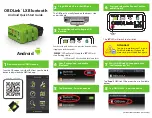
35
/
99
b. AC
:
Block the DC component of the signal
c.
High frequency suppression: Attenuates high frequency components over 40kHz.
d. Low frequency suppression: Attenuates low frequency components below 40kHz.
e. Noise suppression: Suppress high frequency noise in the signal to reduce probability of touch
error.
(4) Pre-trigger / Delayed Trigger
Before trigger event / after collect data.
Trigger position is usually set at the horizontal center of the screen, user can observe 7 grids of pre-
trigger and delay trigger information. Horizontal move the waveform to view more pre-trigger
information. By observing the pre-trigger data, the waveform before generated can be observed. For
example, capturing the glitch at the start of the circuit, observing and analyzing the pre-trigger data
to find out the cause of the glitch.
7.2 Edge Trigger
The edge can be triggered by looking for the specific edge (rising edge, falling edge and random edge)
and electrical level. Press edge trigger menu to set signal source, edge type, alternate trigger and
trigger mode, waveform can be stable generated when the condition is satisfied, as shown in Figure 7-
1.
Figure 7-1
(1) Edge type
:
a. Rising edge: Set to trigger on the rising edge of the signal.
b. Falling edge: Set to trigger on the falling edge of the signal.
c.
Random edge
:
Set to trigger on the rising edge and the falling edge of the signal.
Trigger point
Rising edge
Falling edge
















































